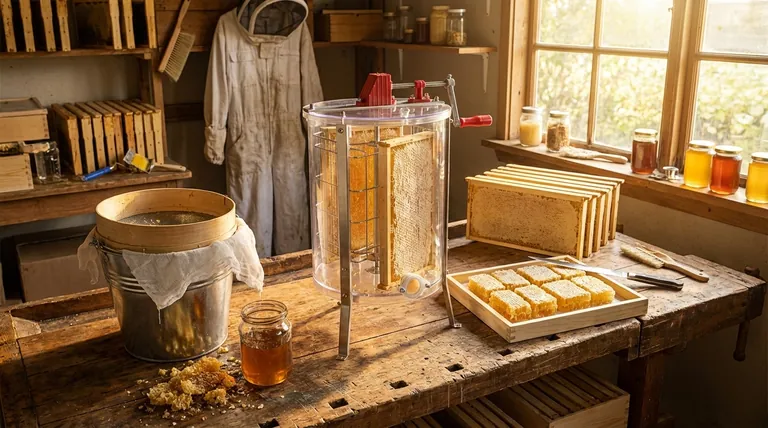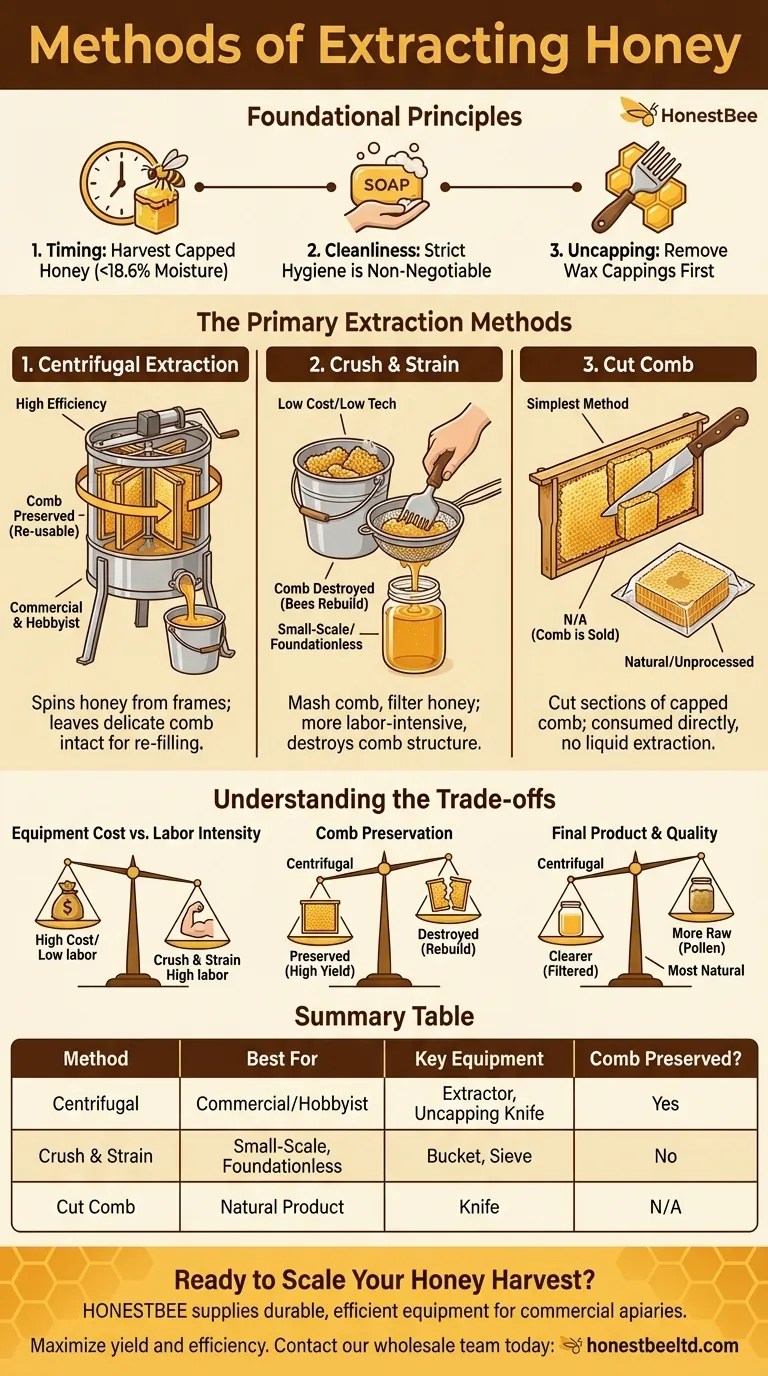In short, there are three primary methods for extracting honey from a comb. These are centrifugal extraction, which spins honey out of the frames; the crush and strain method, which involves mashing the comb and filtering the honey; and the cut comb method, where sections of the honeycomb are cut out to be consumed directly. Each method serves a different purpose, requires different equipment, and has unique implications for the beekeeper and the final product.
The method you choose for honey extraction is a fundamental decision that balances equipment cost, the scale of your operation, and whether you intend to reuse your honeycomb. The core trade-off is between the high efficiency and comb preservation of a centrifugal extractor versus the low-cost simplicity of the crush and strain method.

Foundational Principles of Honey Extraction
Before choosing a specific method, several universal principles ensure a safe, clean, and successful harvest. These steps are foundational to any extraction process.
The Importance of Timing
The best time to extract honey is when the bees have "capped" most of the cells with a thin layer of beeswax. This capping signifies that the honey has been dehydrated to the proper moisture content (below 18.6%) and is ready for long-term storage. Harvesting uncapped, or "green," honey can lead to fermentation.
Maintaining Absolute Cleanliness
Honey is a food product, and strict hygiene is non-negotiable to prevent contamination. Your workspace, tools, and containers must be thoroughly cleaned with soap and warm water. It is essential to keep your hands clean, tie back your hair, and avoid any activities like smoking that could introduce contaminants.
Uncapping the Honeycomb
For any liquid honey extraction (centrifugal or crush and strain), you must first remove the wax cappings from the honeycomb cells. This is typically done with a specialized uncapping knife (which can be heated or cold) or an uncapping fork or scratcher. The removed cappings are rich with honey and are usually collected separately.
The Primary Extraction Methods Explained
With the foundational steps covered, we can now explore the three distinct methods for getting honey out of the comb.
Method 1: Centrifugal Extraction
This is the most common method for commercial and serious hobbyist beekeepers. It involves placing the uncapped frames into a machine called a honey extractor, which spins them at high speed.
Centrifugal force slings the liquid honey out of the cells and onto the walls of the extractor drum. The honey then pools at the bottom and is drained through a gate. The primary advantage is that it leaves the delicate beeswax comb intact within the frame, allowing it to be returned to the hive for the bees to refill.
Method 2: Crush and Strain
This is a low-cost, low-tech method ideal for beekeepers with only a few hives or for those using foundationless combs that cannot be put in an extractor.
The process involves cutting the entire honeycomb out of the frame, crushing it thoroughly to break open all the cells, and placing the resulting mixture of wax and honey into a sieve or cheesecloth. Gravity slowly pulls the honey through the filter, leaving the beeswax behind.
Method 3: Cut Comb
The simplest method of all, cut comb involves no extraction of liquid honey. Instead, you use a clean knife to carefully cut sections of the fully capped honeycomb directly from the frame.
These squares of honeycomb are then packaged and sold or consumed as-is. This method provides the most natural and unprocessed form of honey, but it yields a different final product than liquid honey.
Understanding the Trade-offs
Choosing the right method requires understanding the key differences in cost, efficiency, and impact on your bees and equipment.
Equipment Cost vs. Labor Intensity
A centrifugal extractor represents a significant initial investment but makes the extraction process fast and efficient, especially at scale.
The crush and strain method requires minimal specialized equipment—often just a bucket and a filter—but is significantly more labor-intensive and slower.
The Value of Comb Preservation
The most critical difference between centrifugal and crush-and-strain methods is comb preservation. Bees expend a tremendous amount of energy and resources to produce beeswax and draw it into a perfect honeycomb.
By preserving the comb, an extractor allows bees to immediately start refilling it with honey, leading to a much higher potential honey yield over the season. The crush and strain method destroys the comb, forcing the bees to rebuild it from scratch.
Final Product and Quality
The crush and strain method often results in honey that contains more pollen grains and fine particles, as the filtering is typically less absolute. Some believe this leads to a more robust flavor and nutritional profile.
Centrifugal extraction, especially when followed by fine filtering, can produce a clearer final product. The choice between them often comes down to personal preference for clarity versus a more "raw" character.
Making the Right Choice for Your Goal
Your beekeeping philosophy and practical goals will guide your decision.
- If your primary focus is long-term efficiency and maximizing honey yield: Centrifugal extraction is the correct choice, as preserving the comb is paramount.
- If your primary focus is a low-cost start with foundationless hives: The crush and strain method is the most accessible and practical way to begin harvesting honey.
- If your primary focus is producing the most natural, unprocessed product: The cut comb method provides a beautiful and simple way to enjoy honey directly from the hive.
Ultimately, understanding these core methods empowers you to choose the path that best aligns with your resources, goals, and the needs of your bees.
Summary Table:
| Method | Best For | Key Equipment | Comb Preserved? |
|---|---|---|---|
| Centrifugal Extraction | Commercial & serious hobbyists | Honey extractor, uncapping knife | Yes |
| Crush & Strain | Small-scale, foundationless hives | Bucket, sieve/cheesecloth | No |
| Cut Comb | Natural, unprocessed product | Knife | N/A (Comb is sold) |
Ready to Scale Your Honey Harvest?
Choosing the right extraction method is the first step; having reliable, high-quality equipment is the next. HONESTBEE supplies commercial apiaries and beekeeping equipment distributors with the durable, efficient tools needed for a successful harvest—from uncapping knives to commercial-grade honey extractors.
Let us help you maximize your yield and efficiency. Contact our wholesale team today to discuss your operation's needs and explore our full catalog of beekeeping supplies.
Visual Guide

Related Products
- HONESTBEE 3-Frame Manual Acrylic Honey Extractor
- Electric 8 Frame Honey Spinner Extractor Equipment for Beekeeping
- HONESTBEE 72 Frame Industrial Electric Honey Extractor for Beekeeping
- 8-Frame Electric Self-Reversing Honey Extractor Spinner for Commercial Honey Extraction Equipment
- 2 Frame Stainless Steel Manual Honey Spinner Extractor for Beekeeping
People Also Ask
- Which type of honey extractor is generally more durable? Focus on Material & Build Quality for Longevity
- How to extract honey by hand? A Guide to Crush & Strain vs. Manual Extractors
- How often do beekeepers collect honey? Maximize Your Hive's Sustainable Yield
- What is a fun and easy alternative to using a honey extractor for harvesting honey? Try the Crush and Strain Method
- What machines are needed in beekeeping besides basic tools? Scale Your Honey Harvest Efficiently



















